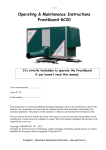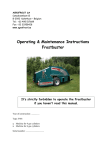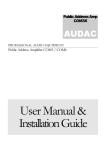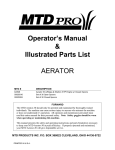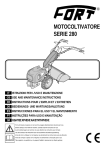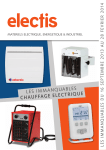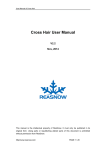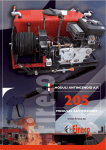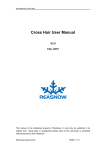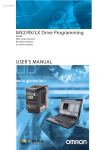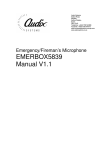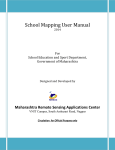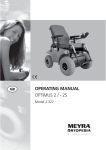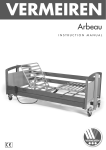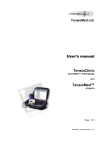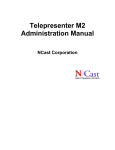Download Agrofrost FrostGuard Owner`s Manual
Transcript
AGROFROST Canadezenlaan 62 B-2920 Kalmthout – Belgium Tel: (+32)(0)495 517689 Fax: (+32)(0)3 295 84 28 www.agrofrost.be Operating & Maintenance Instructions FROSTGUARD Version: .......................... Serial number: ................................. This manual has to be used according the European legislation. It has to be considered as a part of the machine. The manual has to be kept with the machine until the final dismantle as described in the European legislation. The purpose of this manual is to help use and maintain the Frostbuster safely. Agrofrost Operating & Maintenance Instructions - FrostGuard 1 The user manual has to be kept by the owner or the user on a safe, dry and sun protected place on the working area. It must always be available to consult. When the manual is damaged, the user has to ask AGROFROST for a new one. Copyright AGROFROST NV 2000. All rights are strictly preserved. Reprinting, coping, changing, republishing and disclosure is strictly forbidden by all means without recognition of AGROFROST. Furthermore AGROFROST has the rights to change this publication and fulfil changes to the content without preannounce of such changes or rework Agrofrost Operating & Maintenance Instructions - FrostGuard 2 POINTS OF ATTENTION IN THIS MANUAL Hint: to give suggestions and advice to ease certain tasks Attention: a remark with extra information to call your attention for possible problems Warning: to call your attention for avoiding danger ABOUT THE USERS OF THE FROSTGUARD Required user characteristics. Persons who are familiar with the use of agricultural machinery may operate the FrostGuard. They have to be at least 18 years old and be able of all their physical and psychical capacities. They must read this manual before using the FrostGuard. Someone who has not read this manual, cannot use the FrostGuard safely. The profile of the user. The user’s manual is created for two main groups: 1. The user: the person who operates the FrostGuard 2. The mechanical maintainer: the person who does the assembling, maintenance and repairs. The user has to read at least chapter 1, 2, 3, 5, 6 and 8 before using the FrostGuard. The maintainer has to read chapter 1, 2, 3, 5, 6 and 8 before performing any work on the FrostGuard. It is not allowed to use the FrostGuard in a closed area, because of three reasons: 1. The engine and burner consume a lot of oxygen. So the supply of fresh air is very important. 2. The engine produces carbon monoxide, an odorless, colorless, poisonous gas. Breathing carbon monoxide an cause nausea, fainting or death. 3. If gas would escape because of a gas leak, it would create life threatening situations in a closed area because of the danger of explosions. Agrofrost Operating & Maintenance Instructions - FrostGuard 3 Index 1 ASSEMBLING, TRANSPORT AND PLACEMENT. .................................................. 5 1.1 Assembling. ......................................................................................................................... 5 1.2 Transport. ............................................................................................................................. 5 1.3 Placement. ............................................................................................................................ 5 1.4 Positioning. .......................................................................................................................... 6 1.4.1 Positioning of one row of machines. ............................................................................... 6 1.4.2 Positioning of several rows of machines. ........................................................................ 6 2 WHEN AND HOW TO START. ..................................................................................... 7 2.1 When to start and to stop the machine. ................................................................................ 7 2.2 Preparations before to start. ................................................................................................. 7 2.3 To start the machine............................................................................................................. 8 2.3.1 To start the engine. .......................................................................................................... 8 2.3.2 To start the burner. ........................................................................................................... 9 2.3.3 Security .......................................................................................................................... 10 2.3.4 The heating of the gas cylinders. ................................................................................... 10 2.3.5 The use in a closed area. ................................................................................................ 10 2.4 To stop the machine ........................................................................................................... 10 3 MAINTENANCE. ........................................................................................................... 11 3.1 3.2 3.3 4 WARRANTY – SCRAPPING – SPARE PARTS LIST. ............................................. 12 4.1 4.2 4.3 5 Engine. ............................................................................................................................... 11 Burner. ............................................................................................................................... 11 Fan and transmission. ........................................................................................................ 11 Warranty. ........................................................................................................................... 12 Scrapping. .......................................................................................................................... 12 Spare parts list.................................................................................................................... 12 TECHNICAL DATA – WORKING PRINCIPLE - APPLICATIONS..................... 13 5.1 5.2 5.3 Technical data .................................................................................................................... 13 Working principle .............................................................................................................. 13 Applications ....................................................................................................................... 13 6 ENGINE BRIGGS & STRATTON............................................................................... 14 7 EC DECLARATION OF CONFORMITY. ................................................................. 23 8 INSTALLATION PROCEDURE. ................................................................................ 24 Agrofrost Operating & Maintenance Instructions - FrostGuard 4 1 Assembling, transport and placement. 1.1 ASSEMBLING. Al the parts that are delivered separately has to be mounted before use. After the gas cylinders has been connected with the gas hoses, always check for leaks with a leak spray. 1.2 TRANSPORT. The FrostGuard can be moved with a tractor that is equipped with a forklift. Always move the support for the gas cylinders without the gas cylinders mounted. In the fields, orchards, vineyards, do not drive faster than 5 km/hour. 1.3 PLACEMENT. 1. Make sure that the Frostguard is stable and that the legs cannot sink into the ground. 2. If the machine is placed on a slope, attach it to the ground. 3. For the model with outlet below : make sure the outlet is between 20 and 50 cm above the ground. 4. Make sure that the hot air passes under or above the gas cylinders. If the transmission of the outlet falls out for any reason, the hot air stream could overheat the gas cylinders if the airstream is fixed on the gas cylinders. This would create a very dangerous situation. 5. Ask your dealer for the exact position in the field. Every application is different and especially when you put more machines together, the position is very important. 6. Use only propane gas. Another kind of gas will freeze when used at low temperatures. 7. Make sure that the support for the gas cylinders is stable and that the legs cannot sink into the ground, so it cannot turn over. 8. The gas cylinders has to be heated with the exhaust gases of the engine. So connect the exhaust tube to the support of the gas cylinders. Be careful: the exhaust pipe can reach temperatures exceeding 250°C so use protective gloves. If this is not done correctly, the gas cylinders will freeze and the burner will stop after a while. Agrofrost Operating & Maintenance Instructions - FrostGuard 5 1.4 POSITIONING. 1.4.1 Positioning of one row of machines. N 70 m 70 m 70 m 1.4.2 Positioning of several rows of machines. A = 30 m N A 60 m 60 m 60 m A 60 m 60 m 70 m 70 m 70 m 70 m 70 m 70 m 70 m 60 m 70 m 70 a 80 m 70 a 80 m 70 mt 70 m 70 a 80 m 70 a 80 m 70 a 80 m 60 m 70 m 70 a 80 m 70 a 80 m 70 m 70 a 80 m 70 a 80 m 70 a 80 m These values are for the model with the outlet below and for use in orchards, and to protect flowers/blossoms in the different stages. For the model with the outlet above, you can change the values as follows: a. For use in open fields: with 30 to 40 % b. For use in orchards: ask your dealer. To protect small fruits, please ask your dealer. Agrofrost Operating & Maintenance Instructions - FrostGuard 6 2 When and how to start. 2.1 WHEN TO START AND TO STOP THE MACHINE. In case of night frost, start the FrostGuard before the wet temperature drops below 0°C. The machine has to work at least 30 minutes before it will create a positive effect. As soon as the wet temperature outside the treated plot (at least 100 m away from the plot, and against the wind) is again positive, you can stop the FrostGuard. The ideal way to measure the wet temperature: place a plastic film (1m x 1m) on the ground, on the lowest part (coldest point) of the orchard. Place the temperature sensor on this film. Start the engine immediately if the temperature reaches 0°C. A good night frost alarm, connected to a mobile phone, is indispensable. 2.2 PREPARATIONS BEFORE TO START. Make sure that the FrostGuard is put in to place well in advance, so it can be started immediately in case of a night frost. Prepare the following things in advance: a. Place the machine in the right position. Make sure it is stable and that the legs cannot sink into the ground. If the machine is on a slope, attach it to the ground. b. Do not use the FrostGuard on a slope of more than 15 %, otherwise lubrication of the engine is no longer guaranteed. c. Fill the fuel tank sufficiently so that the FrostGuard can operate all night long without refill. (Consumption is approx. 3 litres/hour) d. Never fill the fuel tank whilst the FrostGuard is operating, whilst the engine is running or whilst the burner is burning. e. Never fill the fuel tank whilst the burner or engine or still hot. f. Always place 4 gas cylinders of the support and use them all together. Make sure there is enough gas to last all night. (Gas consumption is approx. 10 kg/hour). g. After mounting the gas cylinders, always check for gas leaks with a leak spray. h. The gas cylinders has to be heated with the exhaust gases of the engine. So connect the exhaust tube to the support of the gas cylinders. Be careful: the exhaust pipe can reach temperatures exceeding 250°C so use protective gloves. Agrofrost Operating & Maintenance Instructions - FrostGuard 7 2.3 TO START THE MACHINE. 2.3.1 To start the engine. A. Throttle/choke control B. Stop switch C. Rope handle D. Fuel shut-off switch To start the engine: a. Turn on the fuel shut-off switch (D). b. Move stop control (B) to ‘ON’ position. c. Move throttle control to ‘FAST’ position. d. If the engine is cold, move choke control (A) to ‘CHOKE’ position. e. Grasp rope handle (C) and pull slowly until resistance is felt. Then pull cord rapidly to overcome compression, prevent kickback and start engine. f. After 5 seconds, put the choke control (A) in position ‘RUN”. Agrofrost Operating & Maintenance Instructions - FrostGuard 8 2.3.2 To start the burner. E. Gas pressure regulator F. Gas valve G. Manometer To start the burner: a. Start the engine (see point 2.3.1). b. Put the throttle control in position ‘SLOW’ but make sure that the fan is still running and does not come to a stop. c. Open all the gas cylinders : it’s important to open them all to prevent them from freezing. d. Make sure that the air outlet is not pointed towards yourself and will not be in the next 3 minutes. If necessary, push it away from you. e. Open the gas valve (F). f. Press the ‘start button’ for one second and control the pressure on the manometer.(G). At 0 C°, the pressure must be between 0,5 and 1 bar. If necessary, adjust the pressure with the gas pressure regulator (E) and check again. g. After you have checked the pressure, always wait at least 10 seconds before lightning the burner. In this way, gas that escaped during the pressure test will be removed by the fan. h. Take a ZIP-lightning block, light it and put it just behind the burning circle. Push the start button. The gas will come out and will start the burner. If the gas starts burning, accelerate the engine immediately (FULL THROTTLE) and keep the start button pushed in for 10 seconds. Then you may release the start button. If the burner falls out, restart at point h. i. If the gas will not burn after 2 seconds, release the start button and wait for at least 15 seconds before trying again. This to make sure that not too many not burned gas will stay in the machine. After 15 seconds, you can make another attempt. j. Adjust the temperature with the gas pressure regulator (E). k. Make sure the temperature stays stable between 80 and 110 °C. It will take a few minutes before the temperature will be stable. Before you leave the machine, make sure that the temperature has been stable for at least one complete turn of the outlet (8 minutes). Agrofrost Operating & Maintenance Instructions - FrostGuard 9 2.3.3 Security The machine has a security that closes the gas in case the the reps of the fan are too low. In this way, the burner will always stop in case of a malfunctioning of the engine are fan. Therefore it’s important that the engine always runs at full speed. 2.3.4 The heating of the gas cylinders. To prevent the gas cylinders from freezing, the exhaust gases are used to heat the gas cylinders. The main tube that supports gas cylinders has 4 holes, one for each gas cylinders, where the hot air exits. It’s important to place the cylinders exactly on top of these holes. 2.3.5 The use in a closed area. It is not allowed to use the FrostGuard in a closed area, because of three reasons: 1. The engine and burner consume a lot of oxygen. So the supply of fresh air is very important. 2. The engine produces carbon monoxide, an odorless, colorless, poisonous gas. Breathing carbon monoxide an cause nausea, fainting or death. 3. If gas would escape because of a gas leak, it would create life threatening situations in a closed area because of the danger of explosions. 2.4 TO STOP THE MACHINE a. b. c. d. e. f. Agrofrost Close the gas valve (F). Close all the gas cylinders. Let the engine run for a few minutes, so the machine can cool down. Move throttle control to ‘SLOW’ position. Move stop control (B) to ‘OFF’ position. Close the fuel shut-off valve (D). Operating & Maintenance Instructions - FrostGuard 10 3 Maintenance. 3.1 ENGINE. a. For maintenance of the Briggs & Stratton engine, see manual of manufacturer. b. Check oil level every 8 hours with the low oil fill (YELLOW) . Oil should be at FULL mark. If oil is required, add slowly and DO NOT OVER-FILL. Use oil SAE 30. c. Change oil every 50 hours. 3.2 BURNER. The burner does not require any maintenance. 3.3 FAN AND TRANSMISSION. Regularly grease the bearings. Agrofrost Operating & Maintenance Instructions - FrostGuard 11 4 Warranty – scrapping – spare parts list. 4.1 WARRANTY. The warranty period is 2 years. The warranty covers all parts that show defects from the beginning and parts manufactured by AGROFROST. This warranty will expire in case of abnormal use, bad maintenance, use of non genuine parts or if the user has not read the manual completely. We do not accept concerning to improvements that me make. 4.2 SCRAPPING. The following table gives an overview of the correct way of disposal of the different parts, in case the Frostbuster has to be dismantled. Part Bearings Oil Engine Frame Screws, bolts, washers Gaskets – gas hoses Way of disposal scrap chemical waste scrap scrap scrap container for synthetic material 4.3 SPARE PARTS LIST. In case you need a spare parts list, please send an inquiry by e-mail to : [email protected] !! Are make an inquiry through our website : www.agrofrost.be !! Agrofrost Operating & Maintenance Instructions - FrostGuard 12 5 Technical data – working principle - applications. 5.1 TECHNICAL DATA Dimensions L x W x H (mm): Type L: 230 x 150 x 150 (with low outlet ) Type H: 230 x 150 x 200 (with high outlet ) Weight without gas cylinders: 290 Kg. Average capacity: Type L (low outlet): oval of 50 by 60 meters. Type H (high outlet) : circle of 80 to 100 meters diameter. Drive of fan: Motor Brigss & Stratton, Vanguard, 13 HP. Average petrol consumption: app. 3 litres/hour. With extra fuel tank of 45 litres. Gas installation: Equipped for 2 of 3 cylinders (depends on cylinder size). Average gas consumption: - approx. 10 kilograms/hour for the model with outlet below - approx. 13 kilograms/hour for the model with outlet above Transport: The FROSTGUARD can be moved easily by a tractor fork lift or with our FrostGuard Lift. 5.2 WORKING PRINCIPLE The success and effectiveness of the FROSTGUARD are a result of the temperature fluctuations that are created by the machine, and of the lowering of the humidity, reducing the possibility of forming ice crystals. The big advantage of creating fluctuations is that this requires much less energy than raising the temperature above the critical values constantly. Therefore, the input of energy is up to 10 times less than with other systems. Machines can be spaced out in groups in relation to the shape and area to be protected. Another important advantage of the FROSTGUARD is that it’s easy to spread the investment over several years: you can start with 1 or 2 machines and buy more during the following years. So, no big initial investment is necessary. 5.3 APPLICATIONS The FROSTGUARD can be used almost everywhere and for several applications: 1) For night frost protection in orchards for all kind of fruits, in vineyards, in greenhouses and plastic tunnels, for strawberries, raspberries, flowers, vegetables, apples, pears, peaches, plums etc. 2) To improve the fruit set in low temperature during blossom. 3) To raise the temperature in plastic tunnels, to bring forward the first harvest date in the beginning of the season, or to pick later at the end of the season. Agrofrost Operating & Maintenance Instructions - FrostGuard 13 6 Engine Briggs & Stratton. Agrofrost Operating & Maintenance Instructions - FrostGuard 14 Agrofrost Operating & Maintenance Instructions - FrostGuard 15 Agrofrost Operating & Maintenance Instructions - FrostGuard 16 Agrofrost Operating & Maintenance Instructions - FrostGuard 17 Agrofrost Operating & Maintenance Instructions - FrostGuard 18 Agrofrost Operating & Maintenance Instructions - FrostGuard 19 Agrofrost Operating & Maintenance Instructions - FrostGuard 20 Agrofrost Operating & Maintenance Instructions - FrostGuard 21 Agrofrost Operating & Maintenance Instructions - FrostGuard 22 7 EC declaration of conformity. EC DECLARATION OF CONFORMITY (Directive 2006/42/EG) We declare under our own responsibility that the machine complies with the safety and health requisities established by the European Directive 2006/42/EG. Manufacturer Address : : Agrofrost SA Canadezenlaan 62 – 2920 Kalmthout Belgium Authorized representative Address : : Stynen Patrik Canadezenlaan 62 – 2920 Kalmthout Belgium Machine : FrostGuard Type .................... Serial number : ................................................. Signature: Patrik Stynen - Director Agrofrost SA Canadezenlaan 62 B-2920 Kalmthout - Belgium Agrofrost Operating & Maintenance Instructions - FrostGuard 23 8 Installation procedure. Installation procedure - Copy for the customer. Customer Dealer Name : …………………………… Name: …………………………………… Address: ………………………… …………………………… …………………………… Address: ………………………………… …………………………………. …………………………………. Technician : ……………………………. FrostGuard Type ……… Serial number : ………….. CHECK LIST & DEMONSTRATION PROCEDURE (To be carried out by the technician and the customer) Demonstration: Positioning of the machine. Start up. Temperature regulation Connection of the gas cylinders Stopping the machine. Precautions and safety measures to be respected: Gas connections (Leak spray). Safety measures delivered with the machine. The user’s manual. Changing the gas cylinders. Storage and transport of the machine and gas cylinders if not in use. Additional information according to the use on a specified terrain and the principle of working. INSTALLATION PROCEDURE COMPLETED I have received the Lazo FrostGuard in satisfactory condition and have received operating and safety training to my satisfaction. Technician signature: ……………………......................... Name in Capitals: …………………………....................... Date: ………………………………………....................... Customer Signature: ……………………………………... Name in Capitals: …………………………………............ Date: ……………………………………….......................... Agrofrost Operating & Maintenance Instructions - FrostGuard 24 Installation procedure - Copy for the dealer/technician. Customer Dealer Name : …………………………… Name: …………………………………… Address: ………………………… …………………………… …………………………… Address: ………………………………… …………………………………. …………………………………. Technician : ……………………………. FrostGuard Type ……… Serial number : ………….. CHECK LIST & DEMONSTRATION PROCEDURE (To be carried out by the technician and the customer) Demonstration: Positioning of the machine. Start up. Temperature regulation Connection of the gas cylinders Stopping the machine. Precautions and safety measures to be respected: Gas connections (Leak spray). Safety measures delivered with the machine. The user’s manual. Changing the gas cylinders. Storage and transport of the machine and gas cylinders if not in use. Additional information according to the use on a specified terrain and the principle of working. INSTALLATION PROCEDURE COMPLETED I have received the Lazo FrostGuard in satisfactory condition and have received operating and safety training to my satisfaction. Technician signature: ……………………......................... Name in Capitals: …………………………....................... Date: ………………………………………....................... Customer Signature: ……………………………………... Name in Capitals: …………………………………............ Date: ……………………………………….......................... Agrofrost Operating & Maintenance Instructions - FrostGuard 25 Agrofrost Operating & Maintenance Instructions - FrostGuard 26 Installation procedure - Copy for AGROFROST. Customer Dealer Name : …………………………… Name: …………………………………… Address: ………………………… …………………………… …………………………… Address: ………………………………… …………………………………. …………………………………. Technician : ……………………………. FrostGuard Type ……… Serial number : ………….. CHECK LIST & DEMONSTRATION PROCEDURE (To be carried out by the technician and the customer) Demonstration: Positioning of the machine. Start up. Temperature regulation Connection of the gas cylinders Stopping the machine. Precautions and safety measures to be respected: Gas connections (Leak spray). Safety measures delivered with the machine. The user’s manual. Changing the gas cylinders. Storage and transport of the machine and gas cylinders if not in use. Additional information according to the use on a specified terrain and the principle of working. INSTALLATION PROCEDURE COMPLETED I have received the Lazo FrostGuard in satisfactory condition and have received operating and safety training to my satisfaction. Technician signature: ……………………......................... Name in Capitals: …………………………....................... Date: ………………………………………....................... Customer Signature: ……………………………………... Name in Capitals: …………………………………............ Date: ……………………………………….......................... This document has to be send back to the manufacturer.. If his document is not send back, the manufacturer reserves the right to refuse any warranty claim. Send to : AGROFROST NV – Canadezenlaan 62 – B-2920 Kalmthout (Belgium). The address is already printed on the other side. Agrofrost Operating & Maintenance Instructions - FrostGuard 27 AGROFROST NV Canadezenlaan 62 B-2920 Kalmthout Belgium Agrofrost Operating & Maintenance Instructions - FrostGuard 28




























